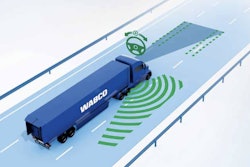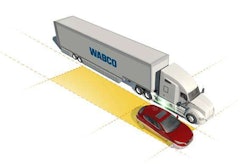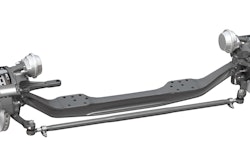 Wabco’s OnLaneAssist uses a hydraulic steering gear and magnetic torque overlay to actively steer when the system senses an unintended lane departure.
Wabco’s OnLaneAssist uses a hydraulic steering gear and magnetic torque overlay to actively steer when the system senses an unintended lane departure.Continuing its development of advanced driver assistance systems, Wabco announced the future availability of OnLaneAssist, a system that builds on its camera-based OnLane lane departure warning system to provide automated steering corrections to keep the vehicle in its designated lane.
The system is capable of distinguishing between accidental lane drifting and an intentional lane change. If OnLane detects a drift, OnLaneAssist intervenes before the vehicle reaches the lane boundary, autonomously applying corrective torque to the steering wheel to return the vehicle to the center of the lane.
“We have for the first time in this country connected the power of controlled braking systems with active steering and are demonstrating how important it is as a technology on the path towards autonomous driving,” said Jacques Esculier, Wabco’s chairman and CEO, during a press conference at the North American Commercial Vehicle Show in Atlanta.
As part of its global active steering solutions strategy, Wabco recently acquired R.H. Sheppard, a Hanover, Penn.-based supplier of commercial vehicle steering technologies. It also signed a cooperative agreement with Nexteer Automotive, an intuitive motion control company, to supply active steering systems for commercial vehicles.
“The braking system is the backbone of vehicle dynamics control on the longitudinal access,” said Esculier. “Active steering gives us access to lateral control capabilities and provides full control of vehicle dynamics, and that is the major differentiator we are building around the acquisition of Sheppard.”
Wabco also announced its OnGuardPlatoon that combines the company’s OnGuardActive’s adaptive cruise control and active braking features with vehicle-to-vehicle (V2V) connectivity to link two or more trucks into a platoon.
“As you reduce the following distance, you significantly enhance the efficiency of both the following and leading vehicle,” said Esculier. “The name of the game is to find technologies to help reduce the following distance without sacrificing safety.”
The existing OnGuardActive system can reduce safe following distances to 2.0 seconds. OnGuardPlatoon’s V2V communications immediately duplicates any braking action by the driver in the leading vehicle on the following vehicle(s), reducing the safe following distance to 1.4 seconds and improving fuel efficiency by 8 percent. Esculier said future steps that manage the way trucks are sequenced based on braking power theoretically could reduce safe following distances to just 0.5 seconds and achieve a 10 percent more fuel efficiency.
Wabco also announced it soon will release OnGuardMax, an extension of OnGuardActive that allows active braking at highway speed on stationary objects using both camera and radar technologies, as well as adaptive cruise control (ACC) in stop-and-go traffic conditions.
North America currently represents 14 percent of Wabco’s $2.9 billion global business. Its recent purchase of Meritor’s share in the Meritor Wabco 50/50 joint venture underscores the company’s desire to grow its business in the NAFTA region.
“This is supporting our ambition to grow as the leader in our space in this part of the world,” said Esculier of the Meritor JV and Sheppard acquisitions.
Wabco now has 1,500 employees serving the North American commercial vehicle market.
The Sheppard purchase comes on the heels of the 2016 acquisitions of Laydon Composites, a Canadian aerodynamic device company, as well as Mico, a manufacturer of hydraulic components and brake systems for off-highway applications.












